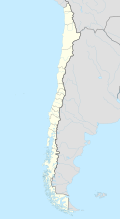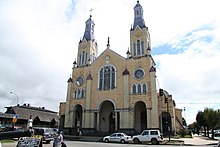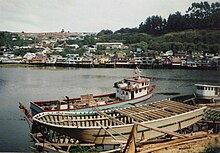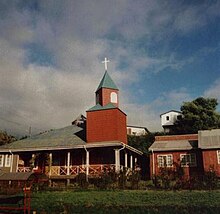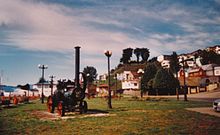Castro (Chile)
Castro is a city in the south of the South American Andean state of Chile with 41,452 inhabitants (Census 2012). It is the capital of the country's second largest island, Chiloé , in the Región de los Lagos .
geography
The city is located roughly in the middle of the island of Chiloé, around 164 km south of Puerto Montt . The Panamericana runs through the city .
The climate is mild, but extremely humid.
In December and January you can take a car ferry from Castro to Chaitén on the continental side.
history
Castro is the third oldest city in Chile and has been continuously inhabited since it was founded. The Huilliche people lived on Chiloé before the Spaniards . In 1540 Alonso de Camargo explored the island's coastlines from a ship. The island was first set foot on November 8, 1553 by Francisco de Ulloa . Castro was founded on February 12, 1567 by the Spanish captain Martín Ruiz de Gamboa . The city, which in 1594 already had 8,000 inhabitants - mostly farmers - was plundered several times by Dutch pirates until the middle of the 17th century and destroyed by an earthquake in 1837.
Castro lost his capital city status on Chiloé when the government moved to Ancud (1788). In 1907 only 1243 inhabitants lived in the city. In 1912 Castro received a railway connection to the city of Ancud, which led to an economic boom. In the Great Chile earthquake on May 22, 1960, Castro was badly damaged. The station and the railway line to Ancud were destroyed and not rebuilt. The town hall and many of the stilt houses also fell victim to the earthquake and the subsequent tsunami. At the time of the 1960 earthquake, Castro had a population of 7,000. It was not until 1982 that Castro became the island's capital again.
economy
Castro lives mainly from tourism, fishing and agriculture.
Attractions
- The main church of the city, the Iglesia de San Francisco, rises on the Plaza de Armas with its well-tended green spaces, the center of Castro, which - like the wooden churches in the districts of Rilán , Nercón and Chelín 2000 - together with others on the island World Heritage Site by UNESCO . The first church stood on this site as early as 1567. Today's building, which was newly built by the Italian architect Eduardo Provasoli after a fire in the neo-Gothic style between 1910 and 1912 , is 52 m long and 27 m wide and is the largest church building on the entire island. The two towers of the church, which was renovated in 1997-99 - the fourth at this point - are 42 m high and visible from afar.
- Famous also are palafitos called stilt houses of fishermen on the coast, mainly in the western district Barrio Gamboa at bay Fiordo de Castro and in the north-east of the city on the coast road Calle Pedro Montt remain. Many of these stilt houses fell victim to the 1960 earthquake and subsequent tsunami.
- In the Barrio Gamboa district, a chapel in the style of the palafitos is also worth seeing.
- Below the city center of Castro there is a shipyard where fishing boats are built in traditional style. From here there is a beautiful view of the pile dwellings of Gamboa.
- An artisan market ( Fería de Artesanía ) south of the port offers plenty of choice for tourists.
- The Regional Museum ( Museo Regional de Castro ) of Castro offers testimonies from the time of the Huillichen and information on the history of the Spanish settlement of Castro.
- Also worth a visit is the Museum of Modern Art Chiloés ( Museo de Arte Moderno de Chiloé ), founded in 1988 .
- Not far north of the port, the Plazuela del Tren , a small park, was created on the former station site . A locomotive and other rail vehicles of the railway line were set up here, which ended at this point until 1960.
- Once a year, in the third week of February, there is a large folklore festival, the Costumbrista Festival .
- Another wooden church, which has been declared a World Heritage Site by UNESCO, is located in the Nercón district, which was incorporated in 2007, about five kilometers south of the city center. It bears the name Iglesia Nuestra Señora de Gracia and was built in 1886-90 mainly from the wood of the Coihue southern beech , whose wood does not rot even in the damp climate of Chiloé. A well-tended garden has been laid out in front of the church, and behind it is the cemetery of the village of Nercón, which already existed in 1627 and had a chapel in this place as early as 1734. The church, declared a national cultural monument on July 27, 1984, is 37.3 m long and 15.3 m wide, its tower reaches a height of 25.36 m.
- Between Nercón and Castro, at the bridge over the river Nercón, there is a small boatyard, boats made of larch wood, and a small votive chapel.
Surroundings
The fjord landscape is ideal for hiking. To the west of Castro lies the Chiloé National Park . To the south is the small town of Chonchi with the well-known Fiesta Criolla summer festival , which takes place in mid-February. On the festival weekend the city is upside down and hundreds of people flock to the otherwise rather quiet town by the sea.
Transport links
From Castro there are good bus connections to all towns on the island of Chiloé, as well as to Puerto Montt and Valdivia on the Chilean mainland. Since 2012, the city of Castro has also had an airport with LATAM Airlines offering three weekly connections to Santiago de Chile .
See also
Individual evidence
- ↑ Report of the IC on the 2012 Population and Housing Census of Chile - Annex 1 ( page no longer available , search in web archives ) Info: The link was automatically marked as defective. Please check the link according to the instructions and then remove this notice.
- ↑ Jorge Sánchez R .: Chiloé - tradición y cultura , p. 31. Santiago de Chile. ISBN 956-309-024-1
- ↑ Dominique Verhasselt: Archipielago Chiloé - el encanto de una isla misteriosa , p. 110. Santiago de Chile 2008. ISBN 978-956-7136-53-7 .
- ↑ Juan Mancilla Pérez: Pueblos de Chiloé , p. 42. Castro 2008
- ↑ Jorge Sánchez R .: Chiloé - tradición y cultura , p. 34. Santiago de Chile. ISBN 956-309-024-1
- ↑ Jorge Sánchez R .: Chiloé - tradición y cultura , p. 33. Santiago de Chile. ISBN 956-309-024-1
- ↑ Dominique Verhasselt: Archipielago Chiloé - el encanto de una isla misteriosa , p. 34. Santiago de Chile 2008. ISBN 978-956-7136-53-7
- ↑ Juan Mancilla Pérez: Pueblos de Chiloé , p. 44. Castro 2008
- ↑ Juan Mancilla Pérez: Pueblos de Chiloé , p. 45. Castro 2008
Web links
- Entry in the UNESCO World Heritage List (English) (French)
- City website
Coordinates: 42 ° 28 ′ S , 73 ° 46 ′ W
